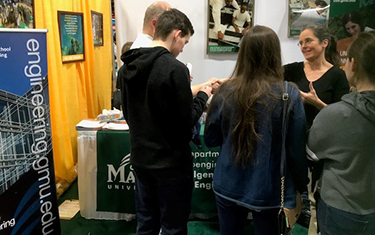It was rewarding for Mason students and faculty to have the opportunity to share our passion for STEM with hundreds of young, enthusiastic, budding scientists and engineers.
Liza Wilson Durant

Beth Johnson and David Holmes in Mason Engineering's Department of Statistics worked with students on hands-on activities involving probability and estimation last weekend at Mason’s megabooth at the USA Science and Engineering Festival in Washington, D.C.

Nathalia Peixoto, an associate professor in the Bioengineering Department and the Electrical and Computer Engineering Department, had students create their own mini-brushbot last weekend at Mason’s megabooth at the USA Science and Engineering Festival in Washington, D.C.
Students of all ages had the chance to create a simple robot, practice probability and statistics with Hershey’s Kisses, and do dozens of other interactive activities last weekend at Mason’s megabooth at the USA Science and Engineering Festival.
The event at the Walter E. Washington Convention Center in Washington, D.C. featured more than 3,000 hands-on exhibits from the world’s leading scientific and engineering societies, universities, government agencies, and high-tech corporations.
Faculty, administrators, and college students from Mason Engineering, the College of Science, the College of Education and Human Development, and several other departments encouraged students to pursue the study of science, technology, engineering and math (STEM).
“Our booth had unique hands-on activities that sparked students' interest in exploring beyond what they are learning in school,” says Kamaljeet Sanghera, executive director of STEM Outreach for the Volgenau School of Engineering. “They didn’t hesitate to try new things.”
Sanghera says middle school students were interested in Mason’s youth conferences, and high school students wanted to learn more about how to get into the university and the types of research being conducted here.
"It was rewarding for Mason students and faculty to have the opportunity to share our passion for STEM with hundreds of young, enthusiastic, budding scientists and engineers," says Liza Wilson Durant, Mason Engineering's associate dean of strategic initiatives and community engagement. "The festival was also an opportunity for different units at Mason to work together on a meaningful project with great impact on the larger community.”
Mason Engineering’s presentations included insights into robots, statistics, and origami engineering. Nathalia Peixoto, an associate professor in the Bioengineering Department and the Electrical and Computer Engineering Department, had students create their own mini-brushbot. They connected a vibrating motor with a tiny battery then taped it to the back of their hand. They could then feel the vibration of this simple robot or wearable device, she says.
Even young children were fascinated with the experiment, and older children asked her if they could use the device to control their own muscles, says Peixoto, director of the Neural Engineering Lab.
The activity prompted lots of questions and conversations about bioengineering, electrical engineering, and mechanical engineering, she says. “I talked to high school students about what George Mason has to offer.”
Beth Johnson, David Holmes, and Linda Davis from the Department of Statistics helped children conduct a probability activity using Hershey’s Kisses, as well as a population-estimating activity involving the number of plastic fish in a bowl.
Using a capture-recapture technique on the fish, the kids learned how to estimate the size of a population that is difficult to measure. Johnson says one 10-year-old girl “almost nailed the correct estimate using her own type of estimation and mental calculations.”
Parents enjoyed the activities as much as the kids. Johnson says. “It was a valuable way to showcase Mason, the Department of Statistics, and the Volgenau School of Engineering.”
The festival is a huge event with many great activities for kids, she says. “I’ve worked at the festival for a few years, but this was the best I’ve seen as far as the number of exhibitors and the quality of hands-on activities encouraging students to pursue a STEM field.”
Our booth had unique hands-on activities that sparked students' interest in exploring beyond what they are learning in school.
Kamaljeet Sanghera
